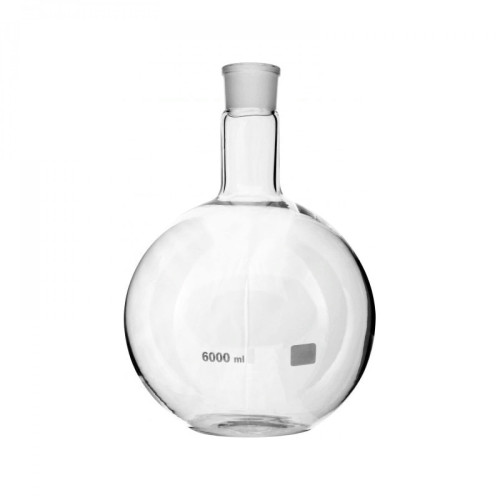Flat-Bottom Flask with Joint
Technical Specifications
Material: Borosilicate glass
Joint Type: Ground joint
Capacity: Available in sizes ranging from 50ml to 2000ml
Temperature Resistance: Can withstand temperatures up to 500°C
Chemical Resistance: Resistant to most acids and alkalis
Dimensions: Vary depending on capacity, with standard neck sizes for compatibility
available soon
Flat-Bottom Flask with Joint
You know that moment when you're running a high-speed stirring reaction and your round-bottom starts doing a slow migration dance across the hotplate? I've clamped more setups at 3am than I care to admit. Flat-bottom flasks with ground joints solve that problem completely—they stay put during 800+ RPM stirring while giving you the same modular joint connections you need for reflux condensers and addition funnels.
Borosilicate 3.3 glass construction handles thermal shock like a champ. I've pulled these straight from 180°C hotplates into ice baths without a single crack, which is more than I can say for cheaper glassware that's ruined plenty of Friday afternoon preps. ASTM E438 Type 1 Class A compliance means consistent wall thickness and annealing quality across every flask in the box.
Preventing Flask Migration During High-Speed Magnetic Stirring
Weight distributes across the entire base so effectively that you can pour reagents through the joint without wobble. Compare this to constantly adjusting cork rings under a Round Bottom Flask with Ground Joint at high speeds—the flat geometry just makes life easier. Unlike a Boiling Flask,flat bottom without integrated joints that needs rubber stoppers, these precision-ground tapers accept condensers and thermometer adapters directly.
Last month I ran a Grignard addition where the stir bar was spinning at 750 RPM for four hours straight. The flask didn't budge a millimeter while my colleague's Boiling Flask,round bottom setup in the next hood required three readjustments. That kind of stability matters when you're adding reagents dropwise and can't afford to break your nitrogen seal.
Ground Joint Compatibility for Sealed Reaction Systems
Ground glass joints create mechanical seals that hold vacuum during distillations and stop solvent creep during those overnight reflux runs you set up before heading home. Most reactions seal fine without grease, though I'll add a microscopic silicone layer when running concentrated base solutions for extended periods.
- 14/23 joints: Microscale work under 25ml where expensive reagents demand conservation—similar sizing to a Conical flask with ground section 14/23 for receiving fractions
- 19/26 sizing: Handles typical 100-250ml organic preps with standard condenser compatibility
- 24/40 standard: Fits most 250-1000ml reactions with broadest accessory availability across different lab stockrooms
- 29/32 openings: Accommodate adding solids or pipette sampling in larger volumes without removing apparatus
Standardized sizing means your 24/40 flask works with any 24/40 condenser in the stockroom. Swap components mid-reaction without hunting through drawers for that one weird adapter. I've built entire distillation trains using nothing but 24/40 components because the interchangeability saves time when you're trying to isolate products before lunch.
Stability Under Vigorous Magnetic Stirring Conditions
Direct hotplate contact transfers heat immediately without the oil bath setup required by round-bottom designs. I've run reflux reactions at 140°C where the flat surface gave me uniform heating across the entire solvent volume—no hot spots that cause bumping or localized decomposition.
Setting up a Dean-Stark trap at 5pm for azeotropic distillation requires confidence that nothing shifts by morning. The flat base maintains position during continuous stirring while joints stay sealed under reflux conditions. Maximum operating temperature reaches 200°C with heating mantles, though direct hotplate use works brilliantly for reactions under 180°C without hassle.
Stir bars center themselves instead of climbing walls during high-speed operation. Watch precipitates form across the flat base without tilting glassware at awkward angles—crystallization monitoring becomes straightforward when nucleation sites appear in a wide, visible plane. Contrast this with a Conical flask, narrow neck where observing solid formation requires peering down a restricted opening.
Flat Base Performance in Sealed Reaction Setups
- 800+ RPM stability: Maintain aggressive stirring for emulsions and suspensions without equipment drift
- Phase separation clarity: Aqueous and organic layers separate in wider, flatter profiles for easier extractions than narrow-neck designs
- Schlenk line compatibility: Accepts septa and three-way adapters for inert atmosphere work
- Thermometer integration: Adapters slide into joints for internal temperature monitoring without drilling stoppers
Capacity ranges from 50ml test reactions up to 5000ml preparative batches, all maintaining uniform thermal distribution. Distillation yields stay high because poorly seated connections can't let vapors escape—ground glass tapers create nearly hermetic seals through mechanical fit alone. I've run vacuum distillations down to 20 torr using just joint-to-joint connections without a single leak.
Chemical resistance covers everything from concentrated acids to organic solvents. Borosilicate 3.3 tolerates hydrofluoric acid exposure better than standard soda-lime glass, though I still swap to plastic labware for extended HF contact. Thermal expansion coefficient sits at 3.3 × 10⁻⁶ K⁻¹, which explains why rapid temperature changes don't shatter properly annealed pieces.
Leave a review about product
Sign up to our newsletter to get the latest news and updates about our products.

